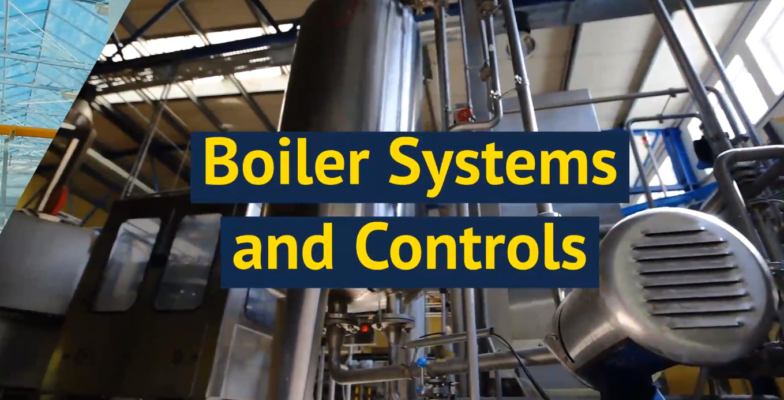Boiler Systems and Controls
Boilers are pressure vessels—generally integrated into a larger system—used to transfer heat between combustion products and water. They are often used in industrial and commercial applications to add energy to water, generating the steam needed for a wide range of critical operations. Depending on the requirements and restrictions of the application, industry professionals employ a variety of different boiler types, including:
- Firetube boilers. In a firetube boiler, the process water surrounds the outside of the heating tubes. As hot combustion gases flow through the tubes, heat transfers from the gases to the tubing material to the water.
- Watertube boilers. In a watertube boiler, the process water runs through the tubes, while the hot combustion gases flow across the outer shell.
- Waste heat recovery boilers. This type of boiler collects waste heat and uses it to heat incoming gases for more efficient steam production.
- Heat recovery steam generators. These are highly efficient heat exchange systems that recover energy from gas turbine exhaust and transfer it to an unfired or supplementary fired generator to create steam or hot water.
At Erdmann Corporation, we specialize in supplying products suitable for use in steam applications, including boiler systems and controls. Whether a customer needs a blowdown valve or heat recovery system for their boiler, we can meet their needs.
Overview of Boiler System Components
A boiler system typically consists of three main components:
- Feedwater system. Feedwater refers to the water that is provided to the boiler for steam conversion. The feedwater system channels water into the boiler and automatically controls it to satisfy steam requirements.
- Steam system. The steam system is the part of the boiler responsible for collecting and regulating the steam generated by the boiler. Valves and pressure gauge controls are used to monitor and regulate steam pressure.
- Fuel system. The fuel system supplies fuel to the boiler for heat generation.
Ensuring these individual components and the overall system function as intended necessitates the use of boiler controls.
How to Control Different Types of Boilers
The method of controlling a boiler system depends on the exact design. For example:
- Commercial boilers can be controlled through on/off cycle, high-fire/low-fire, or modulating control systems.
- Automatic on/off controls switch boiler on or off based on heat demand.
- High-fire/low-fire controls alter the level of the burners—which provide the heat input—to maintain a specific working pressure based on steam demand.
- Modulating controls improve boiler efficiency by monitoring and automatically altering fuel input according to the load demand.
- Multiple boiler systems can be connected together for greater functionality. Controlling this type of system is much the same as a single-boiler system; it can be controlled with automatic on/off cycle, high-fire/low-fire, or modulating controls.
- Modular boilers accommodate a wide range of loads by connecting several boilers together. Each of the boilers turns on when needed and turns off when it is not. For example, if the load exceeds the capacity of a single boiler, an additional one turns on to take up the excess hot water or steam demands.
Boiler Systems and Controls From Erdmann Corp.
Founded in 1933, Erdmann Corporation supplies boiler controls, boiler systems, and other specialty products and services to a variety of industrial sectors, including chemical, distillery, food production, power plants, and more. Our selection of boiler products include:
- Boiler blowdown valves. Blowdown valves remove contaminants that are produced during boiler operations.
- Conductivity meters. Conductivity meters can estimate TDS amounts by measuring the conductivity of boiler water, feedwater, or condensates.
- Feed pump check valves. These valves protect boiler equipment by ensuring that process water flows in the right direction.
- Feed tanks. Feed tanks decrease free oxygen levels from the process water before it is fed into the boiler.
- Heat recovery systems. Heat recovery systems recover energy from condensate before it is discarded or sent back to the boiler.
- Level alarms. Level alarms provide a warning to indicate when boiler water levels are too low or too high.
- Level controls. Level controls are used to regulate liquid, gas, or steam levels.
- Sample coolers. Sample coolers cool water and monitor water quality.
- Steam injection systems. Steam injection systems supply sanitary steam and hot water to boilers, especially those used for distillery purposes.
- Steam traps. Steams traps remove unwanted condensation—i.e., water residue—to improve the performance and increase the service life of steam systems.
- TDS control systems. TDS systems limit the levels of total dissolved solids (TDS) in the boiler.
- Vent heads. Vent heads are used to filter out the condensate and vent steam safely.
For additional information about our boiler systems, boiler controls, and other product offerings, contact us today.


